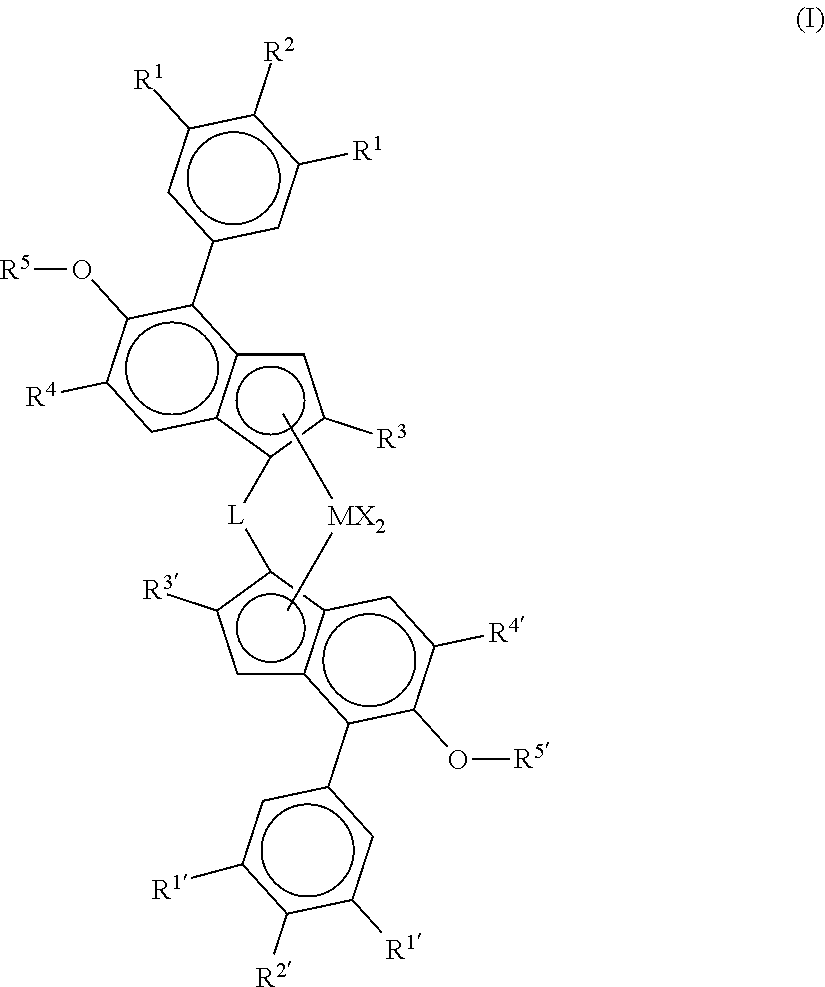Process for preparing heterophasic propylene copolymers
a technology of heterophasic propylene and copolymer, which is applied in the field of process for producing heterophasic propylene copolymer, can solve the problems of difficult to achieve a low bulk-to-gas phase ratio of the produced material, low high activity in gas phase, so as to achieve high activity and high overall productivity of the process.
- Summary
- Abstract
- Description
- Claims
- Application Information
AI Technical Summary
Benefits of technology
Problems solved by technology
Method used
Image
Examples
examples
Metallocene Synthesis
Materials Used for Complex Preparation:
[0249]2,6-Dimethylaniline (Acros), 1-bromo-3,5-dimethylbenzene (Acros), 1-bromo-3,5-di-tert-butylbenzene (Acros), bis(2,6-diisopropylphenyl)imidazolium chloride (Aldrich), triphenylphosphine (Acros), NiCl2(DME) (Aldrich), dichlorodimethylsilane (Merck), ZrCl4 (Merck), trimethylborate (Acros), Pd(OAc)2 (Aldrich), NaBH4 (Acros), 2.5 M nBuLi in hexanes (Chemetal), CuCN (Merck), magnesium turnings (Acros), silica gel 60, 40-63 μm (Merck), bromine (Merck), 96% sulfuric acid (Reachim), sodium nitrite (Merck), copper powder (Alfa), potassium hydroxide (Merck), K2CO3 (Merck), 12 M HCl (Reachim), TsOH (Aldrich), MgSO4 (Merck), Na2CO3 (Merck), Na2SO4 (Akzo Nobel), methanol (Merck), diethyl ether (Merck), 1,2-dimethoxyethane (DME, Aldrich), 95% ethanol (Merck), dichloromethane (Merck), hexane (Merck), THF (Merck), and toluene (Merck) were used as received. Hexane, toluene and dichloromethane for organometallic synthesis were dried ove...
preparation examples
Catalyst Preparation Examples
[0396]MAO was purchased from Chemtura and used as a 30 wt-% solution in toluene. As surfactants were used perfluoroalkylethyl acrylate esters (CAS number 65605-70-1) purchased from the Cytonix corporation, dried over activated molecular sieves (2 times) and degassed by argon bubbling prior to use (Si) or 1H,1H-Perfluoro(2-methyl-3-oxahexan-1-ol) (CAS 26537-88-2) purchased from Unimatec, dried over activated molecular sieves (2 times) and degassed by argon bubbling prior to use (S2).
[0397]Hexadecafluoro-1,3-dimethylyclohexane (PFC) (CAS number 335-27-3) was obtained from commercial sources and dried over activated molecular sieves (2 times) and degassed by argon bubbling prior to use. Propylene is provided by Borealis and adequately purified before use. Triethylaluminum was purchased from Crompton and used in pure form. Hydrogen is provided by AGA and purified before use.
[0398]All the chemicals and chemical reactions were handled under an inert gas atmosp...
PUM
| Property | Measurement | Unit |
|---|---|---|
| Temperature | aaaaa | aaaaa |
| Temperature | aaaaa | aaaaa |
| Ratio | aaaaa | aaaaa |
Abstract
Description
Claims
Application Information
 Login to View More
Login to View More - R&D
- Intellectual Property
- Life Sciences
- Materials
- Tech Scout
- Unparalleled Data Quality
- Higher Quality Content
- 60% Fewer Hallucinations
Browse by: Latest US Patents, China's latest patents, Technical Efficacy Thesaurus, Application Domain, Technology Topic, Popular Technical Reports.
© 2025 PatSnap. All rights reserved.Legal|Privacy policy|Modern Slavery Act Transparency Statement|Sitemap|About US| Contact US: help@patsnap.com



